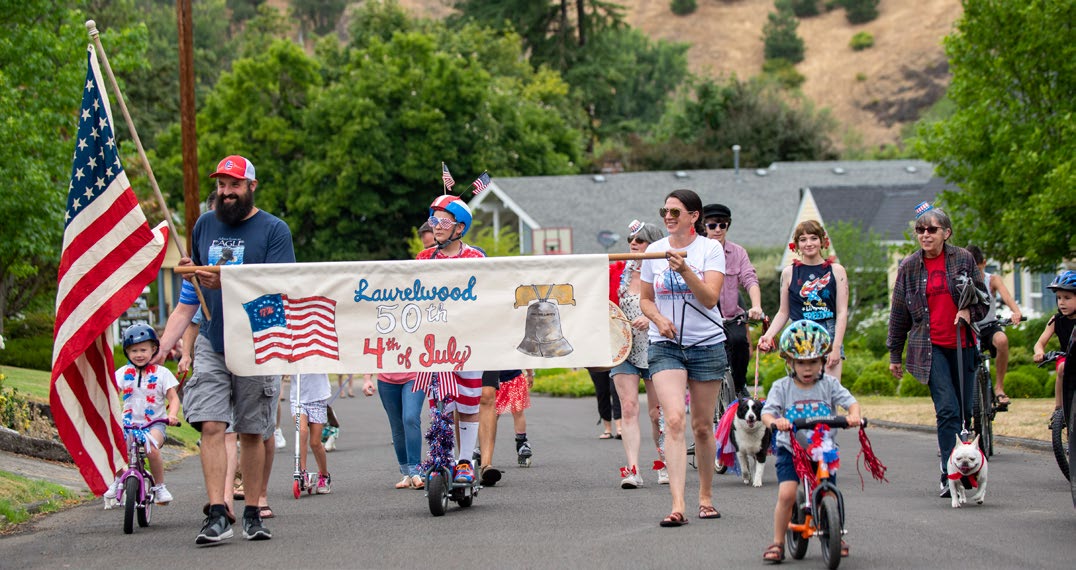The Lure of Laurelwood

There’s no shortage of highly livable, beautiful neighborhoods in Roseburg and Douglas County, but for nostalgia and a true sense of community, there’s nothing quite like the tight-knit enclave of Laurelwood.
Story by Dick Baltus Photos by Robin Loznak
There’s only one way into Roseburg’s Laurelwood neighborhood— turn north off Harvard Avenue onto Madrone, proceed one block and there you are.
For those aspiring to live in the throwback neighborhood built around a park and bordered by Harvard, the South Umpqua River and Roseburg High School, there’s really only one way in as well — get lucky. Homes in Laurelwood don’t go up for sale often, and when they do they typically don’t last long.
In the era of the modern subdivision, the neighborhood is an anachronism. It’s a Leave-it-to-Beaver kind of place in a Modern-Family world, a tight-knit community where neighbors truly get to know each other.
It’s hard not to. Built between 1921 and 1958, Laurelwood’s 90 unique homes — no two are alike — are close enough that a few residents even share driveways. With all homes blessed with plenty of mature trees and foliage, there’s no lack of privacy. But it’s also hard not to be neighborly.
Then again, you don’t move into Laurelwood if you don’t want to be neighborly, says former resident Jacie Pratt, who from 1961 to 2014 lived in the stately brick home built by Roseburg legend Doc Stewart at the north end of Laurelwood Park.
“Over the years, we’ve had a few people move in who thought they were going to just close their doors and keep to themselves, but we weren’t having any of that,” Pratt says, only somewhat kiddingly.
There’s no shortage of highly livable neighborhoods throughout Douglas County, and Laurelwood residents aren’t claiming superiority over any of them. But they aren’t shy about sharing their belief they live in a special place.
After all, what other neighborhood just celebrated the 50th anniversary of its own Fourth of July parade? For that matter, who else lives in a neighborhood that has a long-running special event attached to just about every holiday?
And for certain, no other neighborhood anywhere can call itself the birthplace of the first Metallica Fan Club. In the early ’80s, K.J. Doughton started and ran the club from the basement of his parents’ (Kerwin and Marilyn) home on Riverside Drive. (Doughton later authored Metallica Unbound, the first book ever written about the band.)
Pratt was either responsible for, or played a large role in, establishing many of Laurelwood’s long-running celebrations — the Easter egg hunts in the park; the back-to-school gatherings; the neighborhood Christmas caroling; the Santa Bread baking.
The latter was all Pratt. Every Christmas, she’d bake Santa-shaped breads and deliver them in the darkness of dawn to every Laurelwood family with a child younger than kindergarten age. One year she baked 23 of them.
Pratt carried on that tradition for nearly 25 years — or until the neighborhood had been depleted of qualifying kids—at which point she started opening the Pratt household to her neighbors each year for a holiday season breakfast.
Then there’s Halloween, when the population of Laurelwood grows exponentially with children and parents from other parts of Roseburg that aren’t as trick-or-treat friendly. On a typical Halloween night, it’s not unusual for homeowners to see between 200 and 300 kids.
But the event that started it all, back in 1968, was the Fourth of July parade and picnic. That was another Pratt brainstorm, designed to keep her soon-to-be third-grade daughter and her best friend busy during the summer. “I told myself, ‘You are either going to give those two something to do or they are going to drive everybody in the neighborhood nuts,’” Pratt remembers.
So a parade was planned, with a picnic to follow. A grand marshal was named and a theme announced, and neighbors were encouraged to dress to match it. Kids rode bikes and tricycles around the neighborhood, alongside parents and pets.
“That first Fourth of July, some sort of politician lived in our neighborhood, and when we asked him to speak at the picnic, he gave an actual political speech,” Pratt remembers, laughing.
Another neighbor provided entertainment by playing spoons, and yet another sang a song. “She had a beautiful voice,” Pratt remembers, “but as I remember it, the song she sang was slightly ribald.”
Each year, the parade would take on a life of its own. There have been horses and bands composed of neighbor kids, and when there weren’t enough instrument-playing kids, a neighbor with a boom box would pick up the slack.
Nine current Laurelwood residents lived in the neighborhood as children and have moved back into the homes in which they grew up.
“At its peak, there were probably 50 or 60 people in the parade,” says JoAnne Nelson, who grew up in Laurelwood and returned as an adult to raise a family with her husband, Tom. The Nelsons bought a house directly across from the home JoAnne grew up in and where her parents still lived.
“One Thursday afternoon my mom called and said, ‘Our neighbor, Johanna, is putting her house up for sale,’” Nelson remembers. “I rushed over there and knocked on Johanna’s door. She answered and said, ‘I’ve been waiting for you.’”
The Nelsons weren’t even planning to move, Nelson adds. “We just couldn’t pass up the opportunity.”
Lisa Joyce-Hill.
Nelson is one of many Laurelwood residents who grew up in the area and later returned to live there, says 36-year resident Doug Hunter, the neighborhood’s unofficial historian. After retiring from an 18-year career with Douglas County, Hunter took on the task of developing a website to chronicle life and history in the neighborhood.
He launched the site in 2001, and has since developed a near-encyclopedic knowledge of all-things and all-people Laurelwood, gained from years of documenting through words and photographs the multitude of neighborhood events, celebrations, birthdays, graduations, civic appointments, achievements, movings in and out and births and deaths.
The site even serves as a registry for each Laurelwood home, listing the architectural style, year built and history of ownership.
“The website is really the essence of Laurelwood,” Hunter says.“It’s away for neighbors and former neighbors to keep in touch with each other. When kids head off to school or people move away, they have a way to check back and see what’s happening in their neighborhood.”
According to Hunter, nine current Laurelwood residents lived in the neighborhood as children and have moved back into the homes in which they grew up. Four others who grew up in the neighborhood have moved back into different houses.
“What does that say about this neighborhood?” Hunter asks rhetorically.
Roseburg artist Lisa Joyce-Hill, a resident since 1985, lives just a few houses away from her daughter, Lucia Meyer, who grew up in Laurelwood and just moved back a few months ago.
Joyce-Hill recalls one her favorite neighborhood traditions, Laurelwood After Five on Friday, or LAFF. Now a bring-your-own-dish-and-drink affair held at whichever neighbor feels inclined to play host, the event started as something more than an opportunity to socialize.
Pratt tells the story of an elderly neighbor who leaned over to pick up the newspaper on his porch, lost his balance and fell into a bush. He broke his arm and lay there until the paperboy discovered him a full day later.
Lisa and Doug Hunter.
Determined to never let something similar happen again, Pratt and others planned a gathering to which residents were asked to bring an elderly neighbor whom they would “adopt” and watch over. That turned into a neighborhood party that was held every Friday without fail for 15 to 20 years, Pratt says.
LAFFs continue to this day, though they’ve become more of a monthly event.
Joyce-Hill is responsible for starting her own long-running Laurelwood tradition. For 20 years, she has opened up her backyard garden to the public for an art exhibit. “It has been a delight to have the community come to my garden over the years,” she says. “A number of people return each year, a few of whom have been visiting since my very first Art in the Garden.”
Butch and Marilyn Aller moved to Laurelwood in 1982 after he earned his law degree from the University of Oregon. “We lucked out,” Marilyn says. “We knew somebody who was moving out.”
They’re the second owners of their home. They bought it from the manager of the local J.C. Penney, “Butch” Elliott. “There’s always been a Butch in this house,” Butch Aller says. “We don’t plan to sell any time soon, but if we do it will be a requirement that the buyer either be named Butch or be willing to call himself Butch.”
The Allers’ daughter, Beaverton resident Ursula Berliner, remembers her childhood in Laurelwood as “like growing up in a ’50s sitcom” and in many ways it still is. The strong sense of community and of people making meaningful connections with each other have certainly withstood the test of time.
It didn’t take long for Heather Kehoe, who took on the job of coordinating this year’s 50th Fourth of July event, to experience that herself.
She and her husband, Mark, wound up in Laurelwood the same way most other residents have — by being in the right place at the right time. Three weeks away from the date their first child was due, the Kehoes suddenly found themselves in the position of having to find a new place to rent. They found one in Laurelwood, and six days later Heather went into labor.
“They say walking is the best way to relieve labor pains and get the baby out, so I took a walk around the neighborhood,” Kehoe remembers. “I met several members that day, and I knew this was the place for me.”
Five months later, the owners of the house the Kehoes had been eyeing since discovering Laurelwood asked if they were interested in buying it.
That’s the classic Laurelwood story. Easy to get to. Not so easy to get into. Nearly impossible to leave.
Former, and long-time resident Jacie Pratt is credited with starting many of the enduring traditions for which the Laurelwood neighborhood is famous.











